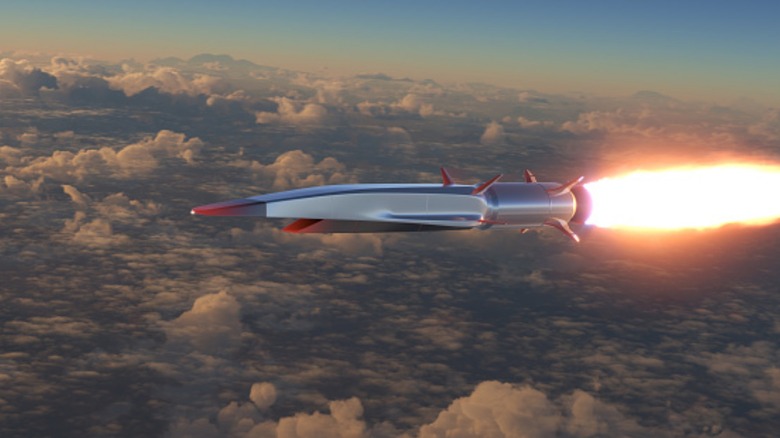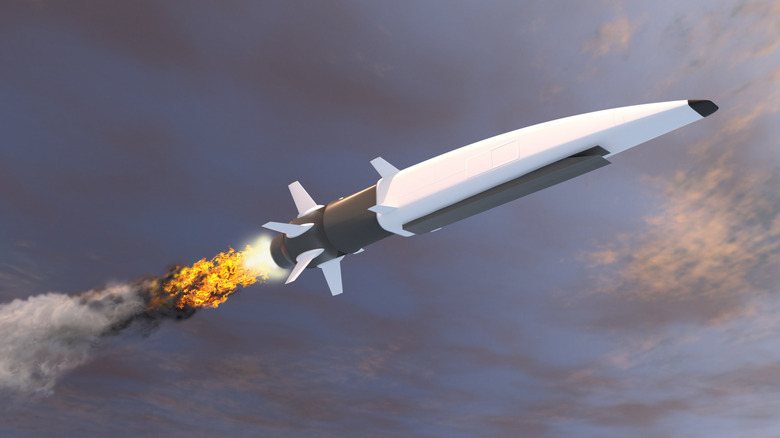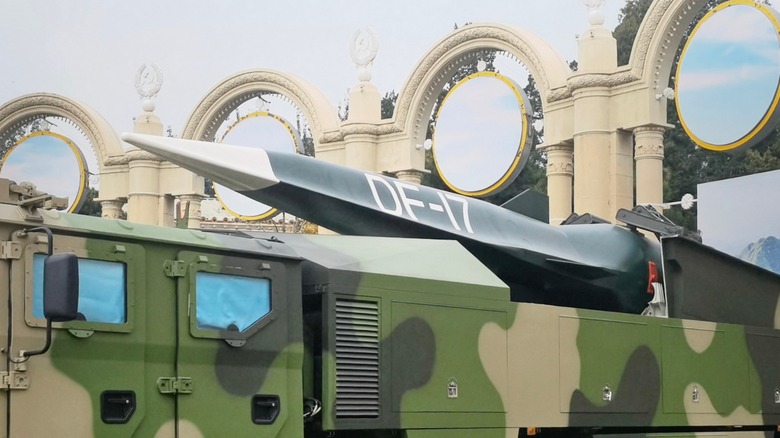How Fast Can A Hypersonic Missile From China Reach The US?
One of the key military innovations of the 21st century is the development of hypersonic missiles. Leading nations are hard at work developing the technology to move missiles five times faster than the speed of sound, otherwise known as Mach 5 (3,636 mph). The Russian and Chinese militaries were the first to develop, employ, and use hypersonic missiles, with Russian hypersonic cruise and ballistic missiles used in Ukraine.
China has developed similar technology, and plenty of western nations are concerned about the nation's new capability. China can already strike the U.S. with intercontinental ballistic missiles (ICBM), which are technically hypersonic. Still, the newer weapons like the Chinese DF-27 can strike Hawaii and are more than capable of penetrating the U.S.' missile defense systems. This is because hypersonic missiles travel so fast that they're all but impossible to intercept, making them especially dangerous for aircraft carriers.
There's not a lot of time between a launch and impact to detect and intercept a hypersonic missile, begging the question, "how fast can they reach the States from China?" The answer depends on several factors, including where they're launched, how fast the individual missiles can travel, and where their target is located. To simplify matters, we'll look at two scenarios: a hypersonic missile attack on Guam from Fuzhou, China, and another from Beijing to Washington, D.C., even though those cities wouldn't actually launch the missiles .
An attack on Guam
You'd think American and Chinese cities are incredibly far apart, thanks to the Pacific Ocean, but the island of Guam, which is a U.S. territory, is only 1,864 miles from the Chinese coastal city of Fuzhou. Meanwhile, the distance from Fuzhou to Los Angeles is 6,827 miles, which is a considerably wider span. China could target Guam with its newest hypersonic weapon, the DF-27A, which is a hypersonic glide vehicle capable of carrying a conventional or nuclear warhead up to 4,981 miles. China isn't exactly advertising the notable characteristics or capabilities of its highly classified hypersonic missiles, however.
There are numerous factors that deal with wind resistance, the time to launch, the curvature of the Earth, and much more, so to keep things as simplified as possible, they won't be considered. To determine the time it takes China to hit Guam from Fuzhou, all you need to do is use the formula time = distance/speed, which comes out to ten minutes. That's barely enough time to detect an incoming missile, making the DF-27A a dangerous threat, especially to American warships.
An attack on Washington D.C.
As of early 2025 the only hypersonic missiles capable of reaching Washington from Beijing are ICBMs. While technically hypersonic, they're not what we're talking about. Instead, let's use a hypothetical hypersonic cruise missile capable of reaching the distance. Cruise missiles remain in the atmosphere, so they can't move as quickly as an ICBM. To strike its target, China would launch the DF-7F, a hypersonic glide vehicle that carries the DF-17 missile to incredible speed.
It's technically a medium-range ballistic missile, but it doesn't fly nearly as high as an ICBM does above the atmosphere. It also can't make the distance, but that's okay for this thought experiment. Unfortunately, like China's other weapon systems, there's little concrete information as to the missile or glide vehicle capabilities. It's believed to be capable of reaching between Mach 5 and Mach 10, so keeping with the conservative estimate, the DF-17 will only travel up to 3,636 mph.
The distance a hypersonic missile would have to fly to travel around the planet to hit Washington from Beijing is 5,448 miles. Traveling at Mach 5, the missile would need one hour, 29 minutes, and 54 seconds to hit its target. Granted, these calculations envision ground-based launches, and there are ship and aircraft launch possibilities that could shorten the time and distance needed to travel. Regardless, the biggest threat hypersonic missiles pose isn't to cities; it's to naval vessels.


